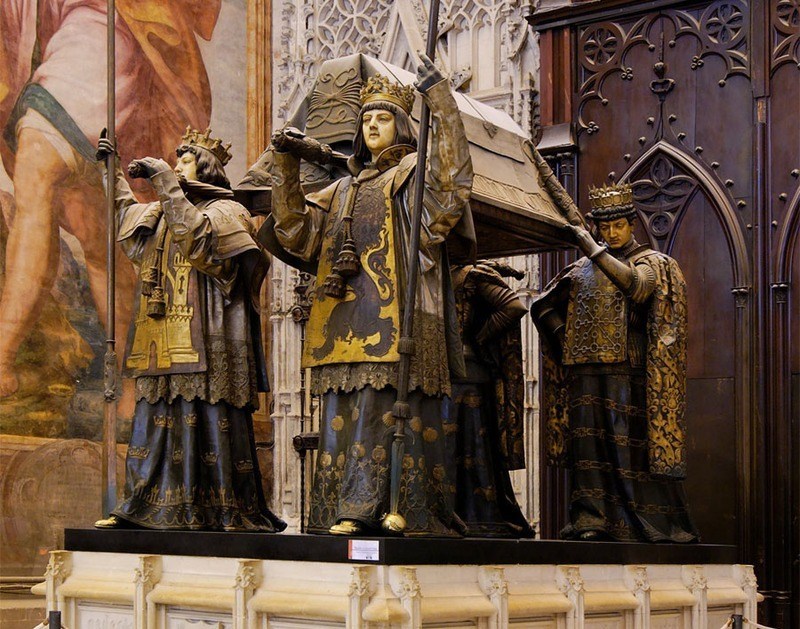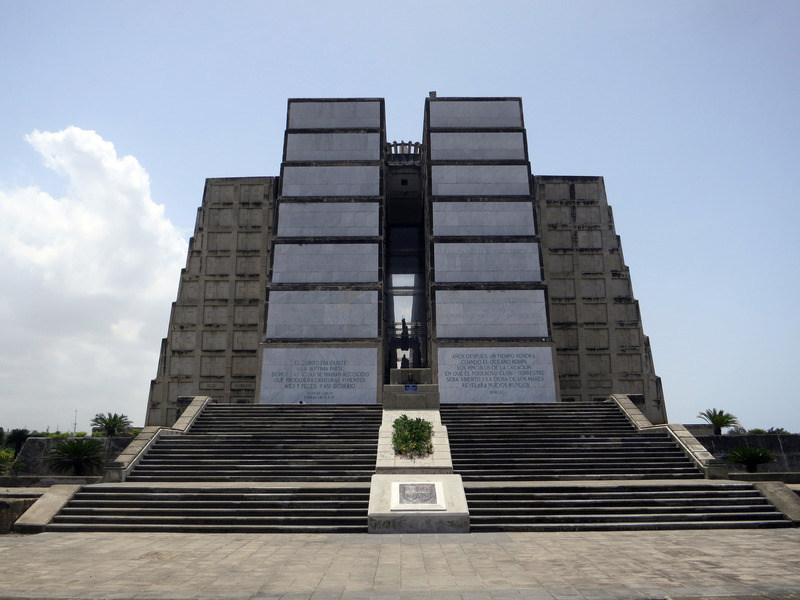
Just inside the Cathedral door of Seville’s massive cathedral stands a monument to Christopher Columbus. His tomb is held aloft by four allegorical figures representing the four kingdoms of Spain during Columbus’ life, Castille, Aragon, Navara and Leon.
The tomb was one of the last additions to the cathedral, installed in 1899. It was designed by the sculptor Arturo Melida, and was originally installed in Havana before being moved to Seville after Spain lost control of Cuba.
Columbus’ body began its final rest in Valladolid, Spain where he died in 1506 at the age of 55. However this was not the end of his adventures. Initially he was buried in Valladolid, but was moved shortly thereafter to Seville, by orders of his son, Diego. Diego, meanwhile travelled to the Dominican Republic to begin construction of a cathedral to hold his father's remains, in accordance with his final wishes. Unfortunately, Diego died in 1526 before he could make that happen, and he was, in turn, interred in Seville next to his father. Both father and son stayed there for another 16 years. When the Cathedral of Santa Maria was completed in the Dominican Republic, Diego's widow put organised to have both bodies moved there.
In 1542, the remains were again moved, this time to Colonial Santo Domingo, in what is now the Dominican Republic, where they joined the body of Christopher's brother, Bartholomew, who had died in Santo Domingo the year before. The body was laid to rest in the newly completed Cathedral, for a couple of centuries, at least.
Then, in 1795 when Spain lost control of the Dominican Republic, they took the explorer's body with them to the other Spanish stronghold in the Caribbean: Havana, Cuba.
100 years later, Columbus’s remans made their final voyage back home to Seville, and were placed in the Cathedral where you can visit him today.
Unfortunately, after all that effort, in 1877, back in the Dominican Republic, nearly a century late, a construction worker working on the Cathedral renovation uncovered a lead box inscribed with the words "The illustrious and excellent man, Don Colon, Admiral of the Ocean Sea.”
At first pass, it seemed obvious that the Spanish must have, in their haste, taken the wrong box. But there's a catch - both father, Christopher, and son, Diego, were known as "Don Colon" in their lifetimes, and both held the same title "Admiral of the Ocean Sea".
By 1898, when the Spanish were pushed out of Cuba by the Americans, both the Spaniards and Dominicans had decided firmly that the remains in their own possession were the authentic item, and that the other must be holding onto the son. Therefore, in Seville an elaborate cathedral tomb was prepared for the explorer's return to his homeland, while in his adopted home another "official" tomb was planned.

It took the Dominicans somewhat longer to get their design act together. It was not until 1931 that a design competition was held, won by a Scottish architect who proposed the 688-foot long cruciform memorial complex that stands today and is known as the “Faro a Colon” – “Lighthouse for Columbus”. The building was barely ready by the 1992 500th anniversary of Columbus' arrival, when the remains were finally interred, taking the whole “mañana” concept to a new level!
In 2003, the controversy was tackled by DNA science, and the remains in Seville tested against known remains of Columbus' brother Diego and son Fernando. Although promising, the results are not conclusive, and thus far, the remains interred at the lighthouse in Santo Domingo Este have not been tested, so for now, the mystery endures.